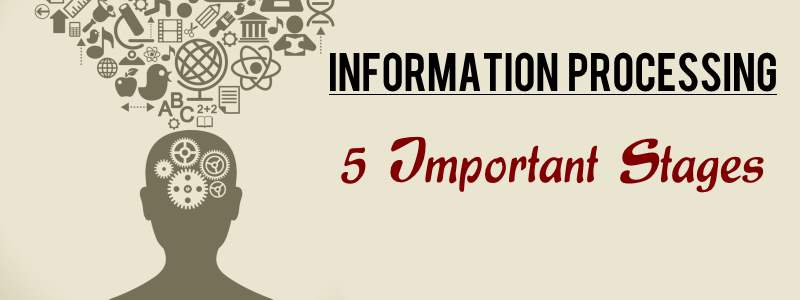Notes on Information Processing | 5 Important Stages
Table of Contents
What is Information Processing?
Marketers want to know how consumers respond to their advertising messages Advertisements provide various stimuli with regard to product, brand names, prices etc. Consumers process these stimuli and react to them. Information processing refers to the process by which a stimulus is received, interpreted, stored in memory and later retrieved.

Stages in information processing
Information processing occurs in five stages
- Exposure
- Attention
- Comprehension
- Acceptance
- Retention
In the “exposure” stage, consumers are exposed to opportunities available in the environment. This leads to activation of consumers. The second stage (attention) represents the allocation of processing capacity to the incoming stimulus. The third stage comprehension includes interpretation of the stimulus. In the fourth stage (acceptance), the stimulus influences the person’s knowledge and attitude. In the final stage (retention), interpreted stimulus is transferred into long term memory.
Each of the stages in information processing is discussed in detail.
1. Exposure Stage in Information Processing
Exposure is the first and the foremost stage in information processing. In this stage, the stimulus input reaches one or more of the five senses. Sensation is defined as “the immediate and direct response of the sensory organs to simple stimuli”. Sensation is affected by three levels, namely
- lower or absolute threshold,
- terminal threshold; and
- difference threshold.
1. Lower or absolute threshold
An individual experiences a sensation at the lowest level known as absolute threshold. At the lowest level, an individual recognizes the difference between something and nothing.
2. Terminal threshold
At terminal threshold level, an additional information increases its stimulus intensity.
3. Difference threshold
Difference threshold represents the minimal difference that can be detected between two stimuli. For example, the marketer effects minimum changes in the product attributes which are not noticeable by buyers (reduction in size, increase in price, etc.). Consumer researchers are of the opinion that stimuli below the threshold level can also be influential. This is known as subliminal persuasion. Subliminal cues enable the marketers to influence consumers without their conscious awareness.
2. Attention Stage in Information Processing
Stimuli which activate sensory receptors are to be processed further. Screening of stimuli takes place at a preconscious level which is known as pre-attentive processing. After the screening process is completed, the simile enter the attention stage.
Attention may be defined as the allocation of processing capacity to a stimulus. The marketer should know the factors that influence the consumer’s allocation of the limited resources. In other words, the marketer should understand what makes consumers selective towards one stimuli than the other. These factors may be of two types, namely, personal factors and stimulus factors.
1. Personal factors
Personal factors include need or motivation, attitudes and span of attention.
a. Need or motivation: An individual is motivated when all his needs are activated. Advertisements focus individual’s needs. Unfulfilled needs frustrate the individuals. To get relief from it, the consumer behavior is directed towards the purchase of the product.
b. Attitudes: People strive to maintain a consistent set of beliefs and attitudes. Inconsistency causes psychological stress. People are more receptive to the kind of conformation which is consistent with their set of beliefs. So, they avoid inconsistent beliefs which challenge their own beliefs and attitudes.
c. Span of attention: The amount of time allocated for a stimulus may vary from person to person. As the span of attention is limited, marketers use more and more shorter commercials.
2. Stimulus factors
Stimulus factors are well within the control of marketers. These factors include colour, size, contrast, position, directionality, movement, isolation etc.
a. Colour: Colour is the most tangible attribute present in an advertisement. The power of stimulus depends upon the type of colour used in the advertisements.
b. Size: Larger size of the stimulus is easily noticeable. For example, a full page advertisement in the newspaper and larger shelf area of a product in a retail shop are more likely to attract the attention of people.
c. Contrast: Contrast colours used in advertisement quickly attracts the attention of individuals.
d. Position: The place where the advertisement is placed has an impact on stimuli of an individual. Generally, advertisements placed at the right place are quickly noticeable. Advertisements placed at unimportant places go unnoticed. In the print media, advertisements placed on the front and back pages are more noticeable.
e. Directionality: Directionality of the advertisement indicates that eye tends to follow any signs within the stimulus.
f. Movement: Moving advertisements are more eye-catching than stationary ones.
g. Isolation: A small number of stimuli presented in barren perceptual field attracts attention.
3. Comprehension Stage in Information Processing
The third stage of information processing is comprehension. It is concerned with interpretation of a stimulus.
Stimulus categorization
Consumers classify stimuli on the basis of concepts stored in memory. Consumers relate the new information with the existing knowledge stored in memory. Personal connections are made between the simulus and one’s life experience. Respondents are asked to write down the thoughts which occur while viewing an advertisement. Now-a-days, advertisers make use of a new concept, namely imagery. Imagery is a process by which sensory information and experiences are represented in a working memory. For example, respondents are asked to imagine the facilities that are required by them in a new housing unit.
Stimulus organization
Stimulus organisation comes within the purview of Gestalt psychology. People organise stimulus by applying some principles. They combine or organise stimuli into a meaningful whole, principles used in stimulus organisation are
- figure and ground,
- grouping and
- closure.
a. Figure and ground
Figure signifies those elements within a perceptual field while the ground represents less meaningful elements that comprise the background. Figure is perceived in contrast to its ground. It appears to be well defined, solid and in the forefront. Contrarily, ground is perceived as indefinite, hazy and continuous. People organise their perceptions into figure and ground. Consumer’s reaction to an advertisement has product as a figure and model etc., as a ground. Some advertisements make other stimuli obvious in the perceptual field rather than the product.
b. Grouping
Individuals group stimuli so that they form a unified picture or impression. Grouping is, therefore, perception of stimuli as group rather than as bits of information. Grouping facilitates memory and recall. People always like simple perceptions even when more complex perceptions can be derived from the simulus.
c. Closure
Closure refers to a tendency to develop a complete picture or perception even when elements in the perceptual field are missing. People add or subtract from stimuli to which they are exposed, according to their expectations. While doing so, they use generalized principles of organization.
Personal determinants of comprehension
The degree of comprehension by an individual is dependent upon some personal factors. These are
- motivation
- knowledge; and
- expectation or perceptual set.
(a) Motivation
Motivation influences the degree of elaboration that occurs during comprehension. An elaborate processing occurs when any product is perceived as personally relevant. If the individual does not require a product featured in an advertisement, then he will not process the advertisement in an elaborate form. The thinking process of the consumer is much activated when the advertised product is personally needed for him.
(b) Knowledge
One of the important determinants of comprehension is the knowledge stored in memory. Stimulus categorization is largely dependent upon knowledge one possesses. Knowledgeable persons have higher ability to elaborate on message claims like the product features. Unknowledgeable persons notice only the peripheral cues like background music, model used for the pictures etc., within the message.
(c) Expectation or perceptual Set
Marketers should carefully study the prior conception or expectations of an individual from a stimulus under the study. The manufactures of Coca-Cola conducted ‘blind taste test’ and “labelled” test for Diet Coke. Consumers could not differentiate when blind test was conducted. But when the samples were labelled, expectations were created. The brand label was powerful enough to change consumer’s perception of the products.
4. Acceptance Stage in Information Processing
Acceptance is the fourth important stage in the information processing. Even if a consumer perfectly understands the message, he may not agree with the message on some grounds. So, message comprehension is not the same as message acceptance. Acceptance of a message is dependent upon the thoughts which occur during the comprehension stage. These thoughts are known as cognitive responses. Further, there are affective responses that have relevance to acceptance theory.
Cognitive responses
A person who is intended to buy a particular product becomes highly motivated while viewing an advertisement which contains that product. The consumer then thinks about the validity of claims the advertisement carries. The nature of these cognitive responses determines the acceptance of the claims. While processing, a consumer is faced with two types of claims:
- Support arguments and
- Counter arguments.
Support arguments are favourable to the claims. It means the product information is accepted in a positive manner. Counter arguments oppose the message.
Cognitive responses help in evaluating communication effectiveness. They reveal whether communication leaves a favourable or unfavourable impression on the viewer.
Affective responses
Affective responses reflect the feelings and emotions that are elicited by a stimulus. It means advertisement impact is dependent upon how it makes us feel. The following reveals the diversity of feelings that advertisement may elicit.
- Anger – affectionate
- Annoyance – calm
- Bad – concerned
- Boredom – contemplative
- Critical – emotional
- Defiant – hopeful
- Depressed – kind
- Disgusted – moving
- Disinterested – peaceful
- Dubious – pensive
- Dull – sentimental
- Fed up – touching
- Insulted – warm hearted
5. Retention Stage in Information Processing
The final stage of information processing is retention. It involves the transfer of information to long term memory. Memory consists of different storage systems:
- sensory memory,
- short term memory,
- long term memory.
1. Sensory memory
In the sensory memory, the incoming information receives and initial analysis is based on properties such as loudness, pitch etc.
2. Short term memory
After sensory memory, the information enters short term memory. Short term memory can accommodate only a limited amount of information at any given point of time. It is also limited in how long information can exist without efforts to keep it activated.
3. Long-term memory
Long term memory can hold unlimited amount of information. It is a permanent storehouse containing all that we have learnt.


